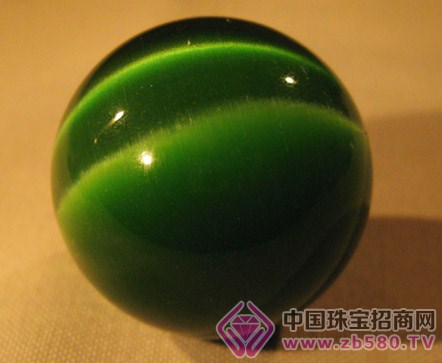
"Cat's Eye" is a very precious and bizarre gem. In the jewelry world, it refers to the "cat eye effect" (also known as "cat eye effect" or "cat eye phenomenon") in gold emeralds, so it can not be used to call any other gemstone with cat eye effect. In mineralogy, both the metamorphic stone and the gold-green opal belong to the same type of gold emerald, but only two different gemstones due to different optical characteristics.
Note: Gold-green cat eyes and marbles belong to the same variety of gold emeralds. Therefore, if it is strictly calculated, gold emeralds, gold-green cat eyes and marbles belong to the fifth high-grade gemstone.
Because it is processed into a curved jewellery (mainly a ring face) with gold emeralds, it has the most beautiful cat eye effect with obvious play color, so it is called cat eye or cat eye. What is especially valuable is that the golden emerald reflects a dazzling light from the inside of the gem under the sun, and its shape is very similar to that of a cat's eyes. At the same time, since the best cat's eye gemstone is produced in Sri Lanka from the east, it is also called "Oriental Cat's Eye" or "Sri Lanka Cat's Eye" (formerly known as "Ceylon Cat's Eye"). In addition, because the world has found that many minerals have cat-eye effects, but their beauty value is far less than the golden-green opal, some people call the gold-green opal stone "true opal."
Gold emerald is a Complex oxide containing barium and aluminum. Its molecular formula is BeAl2O4, which is a raw material for the extraction of barium. It is light greenish yellow or light greenish yellowish brown, glassy, ​​translucent, with a hardness of 8.5 and a specific gravity of 3.5-3.7. One of the best varieties of Sri Lankan cat eyes, a 147.7-carat yellow-green cat's eye gemstone inlaid in the Iranian crown, is produced in Sri Lanka. Among the gem minerals, there are more than twenty known types of cat-eye effects similar to the gold-green opal, which are: ruby, sapphire, aquamarine, quartz (crystal), zircon, cassiterite, tourmaline, and Pyroxene, moonstone, labradorite, feldspar, actinolite, peridot, stellite, andalusite, stubborn pyroxene, serpentine, apatite and malachite. However, their names must be preceded by mineral names, such as malachite cat's eye, or cat's eye malachite (that is, malachite with cat's eye effect), and they cannot simply be called "cat's eye gem" or "Baoyan". stone". The world's most famous gold emerald origin is crystalline and grit-like in the regions of Tranabula and Gower in Sri Lanka.
Together with other gemstones, it is produced in sand mines with a variety of gemstones. Brazil also has yellow-green gold-green opal produced. The Ural Mountains of the Soviet Union were famous for producing golden-green cat eyes, and later the output declined. In 1986, China first discovered malachite with cat-eye effect in the Shilu copper mine in Guangdong, which opened the way for the gemstone with cat-eye effect in China. The opal has a hard texture and calm color, which makes it an ideal gem for men's jewelry. Jewelry in the cat's eye is often adorned with diamonds and set in white gold.
Opal is a kind of chrysoberyl in mineralogy and belongs to the spinel family mineral. Gold emerald is a bismuth-containing aluminum oxide with a chemical formula of BeAl2O4. It is an orthorhombic system. The crystal form is often short columnar or plate-like. Opal has a variety of colors, such as honey yellow, brown yellow, wine yellow, brown yellow, yellow green, yellow brown, gray green, etc., among which honey yellow is the most expensive. Transparent to translucent. Glass to grease luster. The refractive index is 1.746-1.755, and the birefringence is 0.008-0.010. The dichroism is obvious, the dispersion is 0.015, and it is heterogeneous. Hardness 8.5, density 3.71-3.75 g / cm3. Shell-shaped fracture.
The difference between opal and other similar gemstone cat eyes and artificial cat eyes:
Gems that produce cat's eye effect in nature include tourmaline, beryl, apatite, quartz, and kyanite, but they are not as precious as gold-green cat eyes. Tourmaline cat's eye: the hardness is small, 7-7.5, density 3.06 g / cm3, refractive index 1.624-1.644. Quartz cat's eye: low hardness, about 6.5, low density, 2.78 g / cm3, low refractive index, 1.44. Artificial cat's eye: Opal made of artificial glass fiber, brownish yellow, blue and red. However, the artificial opal has 2-3 bright bands at the top of the curved shape, and only one bright band appears in the natural opal. Observed by a magnifying glass, the artificial opal has a hexagonal honeycomb structure with a low hardness of about 5, a low density of 2.46 g/cm 3 and a refractive index of 1.44.
Evaluation and purchase of opal:
The evaluation of opal is based on factors such as color, position of the eyeliner, shape of the gemstone, weight, and the like. High-quality cat's eye gem, the cat's eyeliner should be thin and narrow, and the boundary is clear; the eye should be closed and flexible, and the light should be bright; the cat's eye color should be in sharp contrast with the background; and the cat's eye line should be in the center of the curved surface. When purchasing, the opal should be distinguished from other gemstone cat eyes and artificial cat eyes according to the identification features, and the real opal can be purchased.
Man-Made Fibre,Man Made Fabrics,First Man Made Fibre,Man Made Staple Fibres
SHAOXING CITY TIANHONG TRADE CO., LTD , https://www.sxtianhongfabric.com
![<?echo $_SERVER['SERVER_NAME'];?>](/template/twentyseventeen/skin/images/header.jpg)